The Effect of Canopy Area on Ripening and Wine Quality (2017)
Justin Rose
Rosemont Vineyards and Winery
Summary
This study examines the impact of canopy height and ripening on wine quality in Merlot. Three sets of five rows of Merlot were hedged to different heights in mid-June: 52 inches (High canopy), 44 Inches (Medium canopy, normal height), and 36 inches (Short canopy). All other vineyard treatments were identical. Not much additional shoot growth occurred after hedging. Grapes were harvested on August 25 and processed into separate T Bins. All other treatments were identical. Juice Brix was slightly higher for the short canopy compared to the higher canopy. This may have been due to a seeming resistance to rain dilution seen in the short canopy vine compared to the medium and higher canopy vines. The ethanol, TA, color, and tannin increased with decrease in canopy height, and pH decreased with canopy height. Overall, descriptive analysis had difficulty distinguishing the wines consistently. The short canopy treatment tended to have slightly more Bitterness and Overall Aromatic Intensity. The short canopy wine also exhibited some slight reduction relative to the other two wines, which may have influenced results. Fruit Intensity and Astringency tended to vary between wines between tastings. In general, the high canopy wine tended to be the most preferred. Future studies should examine how bud fruitfulness and yield are impacted by multiple vintages of heavy hedging, pick fruit at different times depending on which treatment is deemed “optimally” ripe, and hedging shoots when they reach their designated height to try to force lateral growth. More studies are needed to confirm the trends seen in this study, as well.
Introduction
There should be a balance between leaf area and fruit yield (Koblet 1975; Smart et al. 1990). Generally, on a vine with 2 clusters per shoot it takes around 10-14 leaves to ripen it, or 0.8-1.2m2 leaf area/kg fruit for single-canopy trellises (Koblet 1975; Kliewer and Dokoozlian 2005), and 0.5-0.8m2/kg for divided canopy trellis systems (Kliewer and Dokoozlian 2005). However, different grape varieties can ripen at different leaf area to fruit yield ratios. Additionally, it is likely that the optimum leaf area to fruit yield ratio would need to be higher in cooler regions (Kliewer and Dokoozlian 2005). Furthermore, this ratio may change depending on the trellising system used, as different trellis types can have different amounts of leaf area required for equal ripening due to more efficient sun exposure of the canopy (Amberg and Shaulis 1966; Shaulis et al. 1966; Shaulis and May 1971; May et al. 1976; Smart 1982; Smart et al. 1982; Kliewer 1982; Shaulis 1982; Kliewer et al. 1988; Smart et al. 1991; Schultz 1995; Gladstone 1999; Kliewer and Dokoozlian 2005). For example, double curtain trellises have higher leaf exposure than single curtain and therefore require less leaf area per kg fruit (0.9-1.0m2/kg vs 1.3-1.4m2/kg) (Kliewer and Dokoozlian 2005).
In general, large canopy surface area which maximizes sun exposure (Smart 1973; Smart et al. 1990) should be developed quickly in the spring, as this allows for increased yield and can promote healthy ripening (Clingeleffer 1989; Smart et al. 1990). Large canopy surface area also reduces canopy density (Shaulis and Smart 1974). However, shoots continue to grow past the optimum balance length, and generally need to be hedged in humid climates (Smart et al. 1990).
An area of vine balance that is often not covered is the disparity between older and younger leaves. Younger leaves are more photosynthetically active than older leaves (Koblet 1969; Yang and Hori 1980; Koblet 1985; Vasconcelos and Castagnoli 2000). Grape leaves overall produce more carbohydrates than they use until they approach 50-80% of their full size (Koblet 1969; Yang and Hori 1980). The rate of photosynthesis in leaves increases until they reach full size, after which the rate declines (Kriedemann et al. 1970; Kurooka et al. 1990). Young leaves, then, may contribute more to ripening than older leaves. Therefore, hedging can be thought of as a way to manipulate the age of the canopy and can be strategically performed at particular growth stages of the vine (Vasconcelos and Castagnoli 2000).
Hedging at the 14th internode over summer enhanced ripening in Switzerland, resulting in higher sugar accumulation and less acidity (Koblet 1985). Others hedged Sangiovese in Italy at the 12th internode 25 days after bloom. Although the leaf area was less in hedged vines than in unhedged vines, hedging increased berry growth, TA, and malate, and reduced pH (Solari et al. 1988). Gewürztraminer ripened more effectively with 10-12 nodes per shoot than with longer shoots (Smart 1985b). In another study, hedging at bloom increased fruit set and cluster weight but decreased total yield, juice pH and leaf area. Longer lateral shoots resulted in higher juice soluble solids, pH, and anthocyanin (Vasconcelos and Castagnoli 2000). Therefore, hedging can benefit certain ripening characteristics, but with seemingly mixed effects on acidity.
This effect on ripening may be because hedging the shoots encourages lateral growth at the hedged tip, which produces younger, more photosynthetically active leaves which can therefore help ripen fruit faster than if only older leaves had stayed on the vine (Hale and Weaver 1962; Koblet and Perret 1971b; Koblet 1985; Hughlin1986; Wolf et al. 1986; Solari et al. 1988; Reynolds and Wardle 1989a; Vasconcelos and Castagnoli 2000). Indeed, the most efficient leaves in the canopy are at the shoot tips and those on laterals (Candolfi-Vasconcelos et al. 1994; Vasconcelos and Castagnoli 2000). Additionally, defoliation increases photosynthetic activity of the remaining leaves (Hunter and Visser 1988). Therefore, some authors recommend not removing lateral shoots near the clusters (Koblet and Perret 1971a), since these shoots are likely to be contributing more photosynthate to the clusters than leaves further up the shoot. However, this is dependent on site (Vasconcelos and Castagnoli 2000). In vigorous sites, lateral shoots result in shading and increased disease incidence (Smart 1985a; Gubler et al. 1987; English et al. 1989; Smart 1994; Vasconcelos and Castagnoli 2000) whereas in less vigorous, cool sites laterals may enhance ripening and vine health (Candolfi-Vasconcelos and Koblet 1990; Vasconcelos and Castagnolie 2000). Other authors have not noticed any effect on lateral shoot growth on ripening. In one study, all lateral shoots were removed from fruit set onwards, with no grape differences except for a slight reduction in TA (Schneider 1985).
Some have found the opposite effect with hedging, reducing Brix, anthocyanins, and increasing pH (even though more light could diffuse through the hedged canopy) (Kliewer and Bledsoe 1986). Furthermore, shoots that are too short may not ripen fruit (Peterson and Smart 1975; Koblet 1987). In vines hedged either at the 6th node or the 10th node (2 leaves past the fruiting zone vs 6 leaves past the fruiting zone), with shoots allowed to regrow after veraison, hedging to the 10th node increased yield, cluster weight, and Brix whereas hedging down to the 6th node decreased these attributes and resulted in poor coloration (Peterson and Smart 1975). Others found that vines with 5 leaves per shoot performed worse than 10 or 15 leaves per shoot, and that hedging at veraison resulted in less ripening than hedging at pre-bloom or at full canopy. This may have been due to increased lateral shoot growth acting as a carbohydrate sink from the 5-leaf treatment (Reynolds and Wardle 1989b). This suggests that a critical leaf density is required in the early stages of grape development to properly ripen. In general, early trimming seems to encourage fruit ripening (Solari et al. 1988; Koblet 1987; Koblet 1988; Smart et al. 1990), and later hedging may discourage ripening (Reynolds and Wardle 1989b). However, severe hedging does not necessarily have to have a very strong impact, or not as strong as would be expected (Reynolds and Wardle 1989b).
It is difficult to draw conclusions on hedging due to the conflicting nature of the results of studies. Differences in these studies may be due to climate (Jackson and Lombard 1993), vintage, and grape variety, and more studies should be performed to evaluate these effects further. However, it appears that in general hedging results in better ripening when compared to just letting the canopy grow incessantly, but at the same time too much hedging can prevent ripening. It is unclear what the result of sustained, severe hedging would be over multiple vintages. Hedging seems to work best when performed around bloom in order to encourage lateral growth. Hedging the vines at veraison, after shoot growth has slowed and laterals have already pushed, may cut away many of the younger, photosynthetically active leaves, slowing down ripening. Sustained continuous hedging throughout the growing season, especially severe hedging, would likely negatively impact fruit ripening, especially if performed over multiple seasons. More studies are needed, however, to gain a better understanding of these trends.
This study examines the impact of hedging a Merlot canopy at different heights on fruit chemistry and on wine quality.
Results and Discussion
The short canopy had an ESCV:CW index of 1, medium canopy had an index of 1, and the high canopy had an index of 1.6. Optimal range is generally considered between 1 and 2, with above 1.5 considered to enhance structure and volume for red wines (IVF 2018). Juice Brix was slightly higher for the short canopy compared to the higher canopy. The short canopy vine appeared to have less berry dilution due to a rain event in August, which may have resulted in its higher Brix. Grapes were harvested on August 25. pH was not affected by canopy height in grapes.
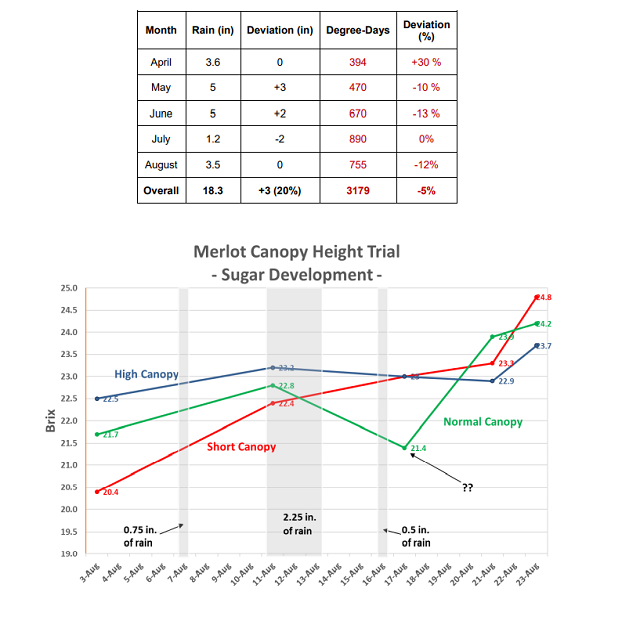
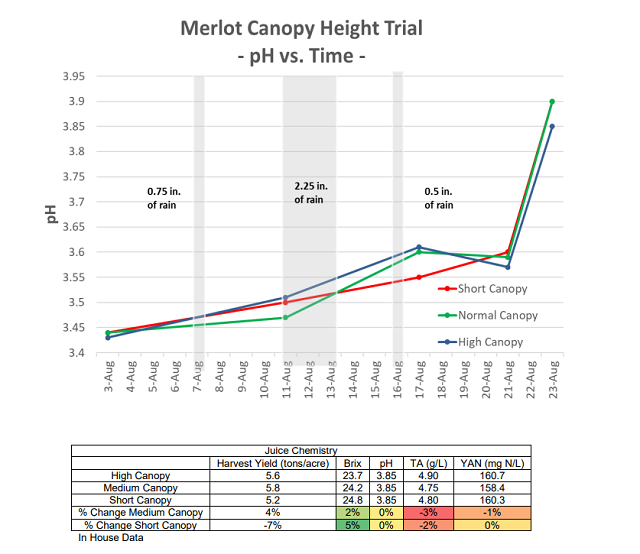
The ethanol, TA, color, and tannin increased with decrease in canopy height, and pH decreased with canopy height. Previous studies have shown similar results (Vasconcelos and Castagnoli 2000), but these results were explained by hedging forcing lateral growth, thus instigating young leaves near the fruiting zone to enhance ripening. But lateral growth was not seen much after hedging in this study. Blind in-house tasting on September 6 and September 9 (after fermentation) suggested the short canopy had best balance and aroma, the medium canopy had better balance and aroma than the high canopy, and the high canopy was least balanced with coarse tannin.

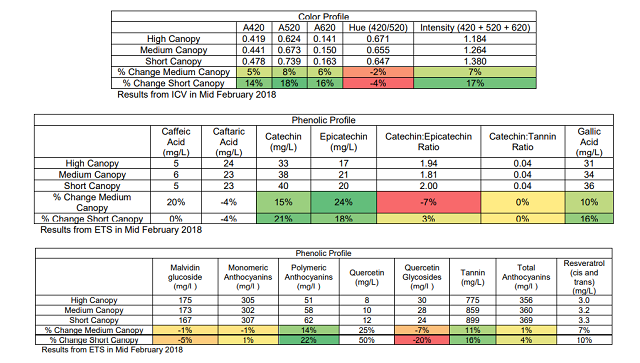
For the descriptive analysis on February 28, there were no strong trends for the descriptors used in this study. Astringency and Fruit Intensity were slightly higher in higher canopy heights. There was a slight preference for the high canopy treatment.
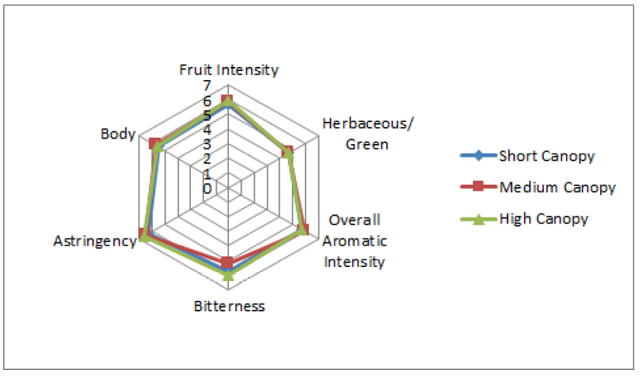

For the March 14 tasting, Bitterness seemed to be slightly higher in the short and medium canopies. The short and high canopy treatments seemed slightly higher in Overall Aromatic Intensity. There was a very slight preference for these two treatments.
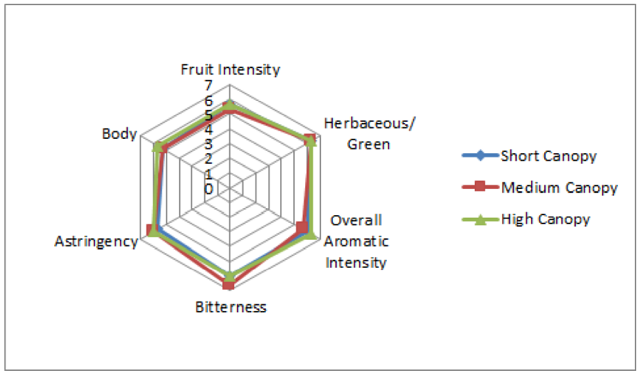
For the descriptive analysis on May 9, there were no strong trends for the descriptors used in this study. There was a slight tendency for the short canopy wine to have higher Overall Aromatic Intensity, Bitterness, and Astringency. The high canopy wine had a slight tendency to have lower Fruit Intensity and Bitterness. In general, judges preferred the high canopy the most, and the short canopy the least.
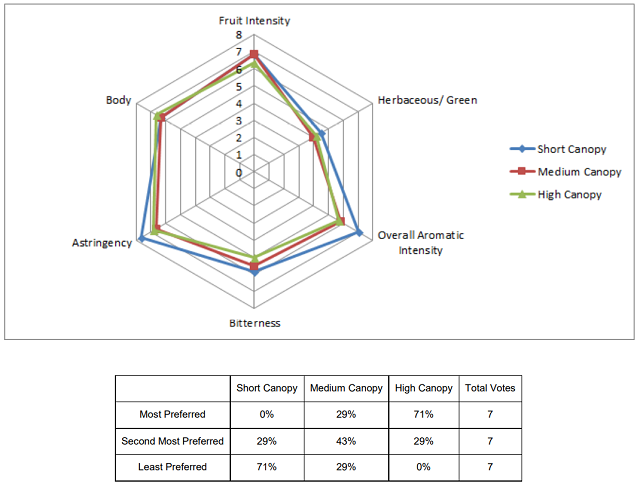
Overall, descriptive analysis had difficulty distinguishing the wines consistently. The short canopy treatment tended to have slightly more Bitterness and Overall Aromatic Intensity. The short canopy wine also exhibited some slight reduction relative to the other two wines, which may have influenced results. Fruit Intensity and Astringency tended to vary between wines between tastings. In general, the high canopy wine tended to be the most preferred. Future studies should examine how bud fruitfulness and yield are impacted by multiple vintages of heavy hedging, pick fruit at different times depending on which treatment is deemed “optimally” ripe, and hedging shoots when they reach their designated height to try to force lateral growth. More studies are needed to confirm the trends seen in this study, as well.
Methods
Three sets of five rows of Merlot 343 (13 years old) on RG rootstock on cane pruned VSP, 6x4 spacing were used for this trial. Canopy depth was approximately 8 inches. These rows are planted on a slight slope which is perpendicular to the direction of the rows. All 15 rows were treated the same throughout the growing year except that after fruit set each set of rows were hedged at different heights until harvest as follows below:
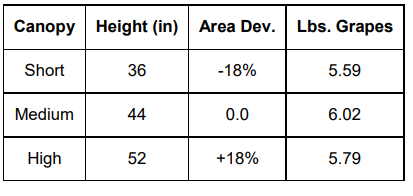
Bud break was on April 2, flowering on May 2, the vines were hedged Mid-June, veraison occurred on July 14, and the fruiting zone was netted on August 4. Vines were not hedged anymore after the initial hedging, and not much additional lateral growth was observed, possibly due to low rainfall in July and August.
Grapes were harvested on August 25 (42 days of ripening, 145 days from bud break to harvest). They were then refrigerated overnight and processed on August 26 into three separate T Bins. Each T Bin received 50ppm sulfur dioxide, 30g/hL Tannin VR Supra, and 40 g/ton HE Grand Cru Enzyme. Must was cold soaked for 5 days at 50°F.
All T Bins were inoculated on August 31 with X-Pure yeast at 25g/hL, with 30g/hL Dynastart. During fermentation, each treatment received 30g/L Thiozote, 30g/hL Nutristart Org, 15g/L VR Color, and 1g/L tartaric acid. Each fermentation received 2-3 punchdowns per day until September 7, and then one punch down per day until pressing. Only free run wine was used. Malolactic bacteria were added on September 4. Wines were pressed on September 13.
These wines were tasted on February 28, March 14, and May 9. In order to balance the data set to perform statistical analysis for descriptive analysis on the February 28 tasting, any judge who had not fully completed the descriptive analysis ratings were removed. In order to then make the number of judges between groups equivalent, two judges from group 2 were transferred to group 1. This resulted in a final data set of 3 groups, each with 8 judges (considered as replications within groups, and groups were considered as assessors). Data was analyzed using Panel Check V1.4.2. Because this is not a truly statistical set-up, any results which are found to be statistically significant (p<0.05) will be denoted as a “strong trend” or a “strong tendency,” as opposed to general trends or tendencies. The statistical significance here will ignore any other significant effects or interactions which may confound the results (such as a statistically significant interaction of Judge x Wine confounding a significant result from Wine alone). The descriptors used in this study were Fruit Intensity, Herbaceous/Green, Overall Aromatic Intensity, Bitterness, Astringency, and Body.
Due to the very small number of judges (3) at the March 14 tasting, only slight trends will be discussed for the sensory information.
The same procedures for data analysis were used on the May 9 tasting as were used on the February 28 tasting. For the descriptive analysis in this tasting, one judge was eliminated from group one so that each group had two judges, for a total of 6 judges.
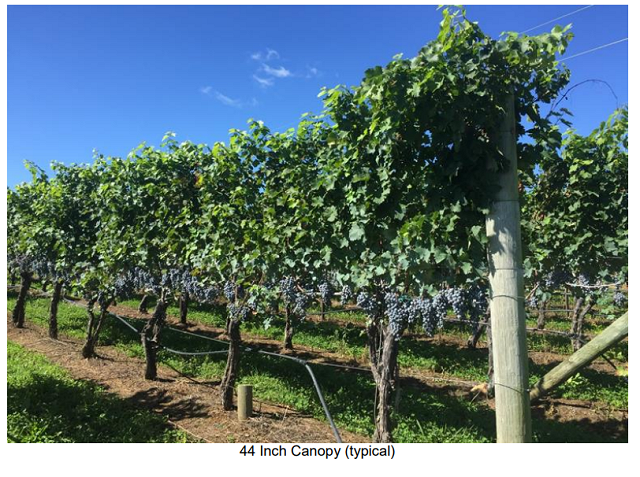
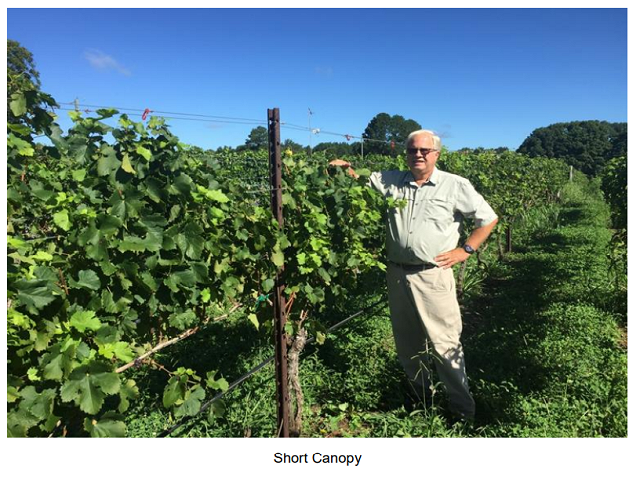
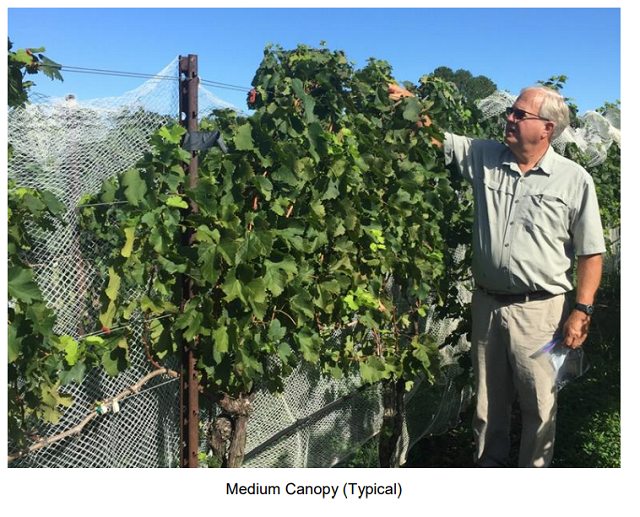
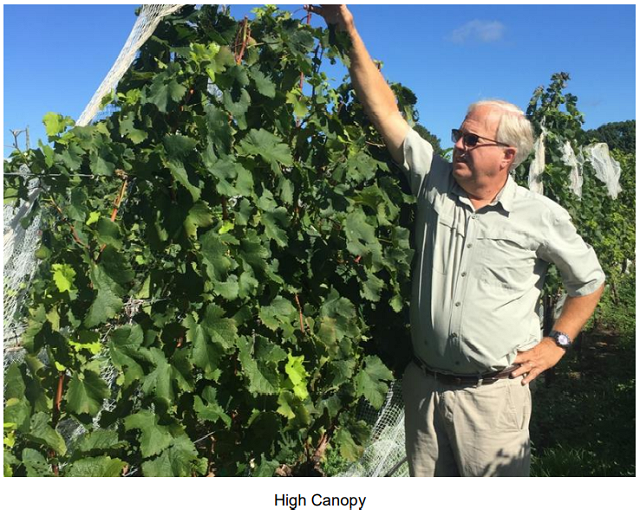
References
Candolfi-Vasconcelos, M. C. and Koblet, W. 1990. Yield, fruit quality, bud fertility and starch reserves of the wood as a function of leaf removal in Vitis vinifera. Evidence of compensation and stress recovering. Vitis 29:199-221.
Candolfi-Vasconcelos, M. C., Koblet, W., et al. 1994. Influence of defoliation, rootstock, training system and leaf position on gas exchange of Pinot noir grapevines. Am. J. Enol. Vitic. 45:173-180.
Clingeleffer, P. 1989. Update: minimal pruning of cordon trained vines (MPCT). Aust. Grape grower and Winemaker 304, 78-83.
English, J. T., Thomas, C.S., Marois, J.J., and Gubler, W.D. 1989. Microclimates of grapevine canopies associated with leaf removal and control of Botrytis bunch rot. Phytopathology 79:395-401.
Gladstone, E.A. 1999. Interaction of canopy size and trellis/training system on grapevine canopy microclimate. MS thesis, University of California, Davis.
Gubler, W. D., Marois, J.J., et al. 1987. Control of Botrytis bunch rot of grape with canopy management. Plant Disease 71:599-601.
Hale, C. R. and Weaver, R.J. 1962. The effect of developmental stage on direction of translocation of photosynthate in Vitis vinifera. Hilgardia 33:89-141.
Huglin, P. 1986. Biologie et Écologie de la Vigne. 372pp. Éditions Payot, Lausanne.
Hunter, J. and Visser, J. 1988. Distribution of 14C- photosynthetate in the shoot of Vitis ViniferaL. cv. Cabernet Sauvignon. II. The effect of partial defoliation. S. Afr. J. Enol. Viti.c 9:10-15.
IVF. 2018. Le rapport feuilles/fruits ou indice SECV/PR. Accessed May 15, 2018. http://www.vignevin-sudouest.com/publications/fiches-pratiques/feuilles-fruits.php
Jackson, D.I. and Lombard, P.B. 1993. Environmental and management practices affecting grape composition and wine quality: A review. Am. J. Enol. Vitic. 44:409-430.
Kliewer, W. M. and Bledsoe, A. 1986. Influence of hedging and leaf removal on canopy microclimate, grape composition, and wine quality under Californian conditions. HortScience 21 (3) Abstract No. 1606.
Kliewer, W.M. 1982. Vineyard canopy management – A review. In Grape and Wine Centennial Symposium Proceedings. 18-21 June 1980, Davis, CA. A.D. Webb (Ed.), pp. 342-352. University of California, Davis.
Kliewer, W.M. and Bledsoe, A. 1987. Influence of hedging and leaf removal on canopy microclimate, grape composition, and wine quality under California conditions. Acta Horticulturae 206, 157-168.
Kliewer, W.M. and Dokoozlian, N.K. 2005. Leaf area/crop weight ratios of grapevines: influence on fruit composition and wine quality. Am. J. Enol. Vitic. 56:170-181
Kliewer, W.M., Marois, J.J., et al. 1988. Relative effectiveness of leaf removal, shoot positioning and trellising for improving winegrape composition. In Proceedings of the Second International Symposium for Cool Climate Viticulture and Oenology. 11-15 Jan. 1988. R.E. Smart et al. (Eds.), pp. 123-126. New Zealand Society for Viticulture and Enology, Auckland.
Koblet, W. 1969. Translocation of photosynthate in vine shoots and influence of leaf area on quantity and quality of the grapes. Wein-Wiss. 24:277-319.
Koblet, W. 1975. Deplacement des produits d'assimilation des diffèrentes feuilles de la vigne pendant la maturation des raisins. Wein-Wiss. 30:241-249.
Koblet, W. 1985. Influence of light and temperature on vine performance in cool climates and applications to vineyard management. In: Proceedings of the International Symposium on Cool Climate Viticulture and Enology. D. A. Heatherbell, P. B. Lombard, F. W. Bodyfelt, and S. F. Price (Eds.) pp 139-157. Eugene, OR. Oregon State University Experiment Station Technical Publication No. 7628.
Koblet, W. 1987. Effectiveness of shoot topping and leaf removal as a means of improving quality. Acta Horticulturae-206, 141-156.
Koblet, W. 1988. Canopy management in Swiss vineyards. Proc. Second Int. Symp. Cool Climate Viticulture and Oenology, January 1988, Auckland, New Zealand. NZ Soc. for Vitic. and Oenol., 161-164.
Koblet, W., and Perret, P. 1971a. Amelioration des travaux au vest de lavigne. Rev. Swisse Vitic. Arbor. 4:112-117.
Koblet, W., and Perret, P. 1971b. Kohlehydratwanderung in Geiztrieben von Reben. Wein-Wiss. 26:202-211.
Kriedemann, P. E., Kliewer, W.M., and Harris, J.M. 1970. Leaf age and photosynthesis in Vitis vinifera L. Vitis 9:97-104.
Kurooka, H., Fukunaga, S., et al. 1990. Effect of carbon dioxide enrichment on vine growth and berry quality of Kyoho grapes. J. Japan. Soc. Hortic. Sci. 59:463-470.
May, P., Clingeleffer, P.R., Scholefield, P.B., and Brien, C.J. 1976. The response of the grape cultivar Crouchen (Australian Syn. Clare Riesling) to various trellis and pruning treatments. Austr. J. Agri. Res. 27:845-856.
Peterson, J. amd S,art. R. 1975. Foliage removal effects on Shiraz grapevines. Am. J. Enol. Vitic. 26, 119-124.
Reynolds, A. and Wardle, D. 1989a. Effects of timing and severity of summer hedging on growth, yield, fruit composition, and canopy characteristics of de Chaunac. I. Canopy characteristics and growth parameters. Am. J. Enol. Vitic. 40, 109-129.
Reynolds, A. G., and Wardle, D.A. 1989b. Effects of timing and severity of summer hedging on growth, yield, fruit composition, and canopy characteristics of de Chaunac. II. Yield and fruit composition. Am. J. Enol. Vitic. 40:299-308.
Schneider, C. 1985. Influence de la suppression des entre couers de souches de vigne sur la microclimat lumineux et la rècolte. Connaissance de la Vigne et du Vin. 19:17-30.
Schultz, H.R. 1995. Grape canopy structure, light microclimate and photosynthesis. I. A two-dimensional model of the spatial distribution of surface area densities and leaf ages in two canopy systems. Vitis 34:211-215.
Shaulis, N. and May, P. 1971. Response of Sultana vines to training on a divided canopy and to shoot crowding. Am. J. Enol. Vitic. 22:215-222.
Shaulis, N. and Smart, R. 1974. Grapevine canopies: management, microclimate and yield responses. Proc. XIXth Int. Hort. Congress, September 1974, Warsaw. 254-265.
Shaulis, N.J. 1982. Responses of grapevines and grapes to spacing of and within canopies. In Grape and Wine Centennial Symposium Proceedings. 18-21 June 1980, Davis, CA. A.D. Webb (Ed.), pp. 353-360. University of California, Davis.
Shaulis, N.J., Amberg, H., and Crowe, D. 1966. Response of concord grapes to light exposure, and Geneva double curtain training. Proc. Am. Soc. Hortic. Sci. 89:268-280.
Smart, R. 1973. Sunlight interception by vineyards. Am. J. Enol. Vitic. 24, 141-147.
Smart, R. E. 1985a. Principles of grapevine microclimate manipulation with implications for yield and quality. A review. Am. J. Enol. Vitic. 36:230-239.
Smart, R. E. 1985b. Some aspects of climate, canopy microclimate, wine physiology and wine quality. In: Proceedings of the International Symposium on Cool Climate Viticulture and Enology, Eugene, Oregon. D. A. Heatherbell, P. B. Lombard, F. W. Bodyfelt, and S. F. Price (Eds.). Oregon State University Experiment Station Technical Publication No. 7628 pp 1-19.
Smart, R. E. 1994. The Effect of Manipulating Grapevine Vigor and Canopy Microclimate on Yield, Grape Composition and Wine Quality. Doctor of Science thesis, University of Stellenbosch.
Smart, R.E. 1982. Vine manipulation to improve wine grape quality. In Grape and Wine Centennial Symposium Proceedings. 18- 21 June 1980, Davis, CA. A.D. Webb (Ed.), pp. 362-375. University of California, Davis.
Smart, R.E., Dick, J.K., et al. 1991. Canopy management to improve yield and quality: Principles and practices. S. Afr. J. Enol. Vitic. 11:3-17.
Smart, R.E., Dick, J.K., Gravett, I.M., and Fisher, B.M. 1990. Canopy management to improve grape yield and wine quality – principles and practices. S. Afr. J. Enol. Vitic. 11:3-17 Amberg, H., and N.J. Shaulis. 1966. Techniques for controlled climate studies in Concord grape vines. In Proceedings of the VXIII International Horticultural Congress. International Society for Horticulture Science 1:588.
Smart, R.E., Shaulis, N.J., and Lemon, E.R. 1982. The effect of Concord vineyard microclimate on yield. I. The effect of pruning, training and shoot positioning on radiation microclimate. Am. J. Enol. Vitic. 33:99-108.
Solari, C., Silvestroni, O., Guidici, P., and Intrieri, C. 1988. Influence of topping on juice composition of Sangiovese grapevines (Vitis vinifera L.). In: Proceedings of the Second International Symposium for Cool Climate Viticulture and Oenology, Auckland, NZ. R. E. Smart, R. J. Thornton, S. B. Rodriguez, and J. E. Young (Eds.). pp 147-51.
Vasconcelos, M.C. and Castagnoli, S. 2000. Leaf canopy structure and vine performance. Am. J. Enol. Vitic. 51:390-396.
Wolf T. K., Pool, R.M., and Mattick, L.R. 1986. Responses of young Chardonnay grapevines Vitis vinifera to shoot tipping, ethephon, and basal leaf removal. Am. J. Enol. Vitic. 37:263-268.
Yang, Y. S. and Hori, Y. 1980. Studies on retranslocation of accumulated assimilates in “Delaware” grapevines. III. Early growth of new shoots as dependent on accumulated and current year assimilates. Tohoku J. Agricult. Res. 31:120-129.
